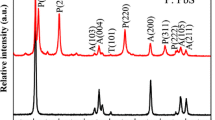Abstract
TiO2 nanotube arrays with high surface areas have grown in significance recently due to their excellent charge transport properties. However, they can only be excited by ultraviolet irradiation due to their wide band gap; this drawback has greatly limited their applicability to real-world devices. In this study, a series of heterostructured black-Cr–SrTiO3/TiO2 nanotube arrays with heterojunction structures were successfully fabricated using a hydrothermal method; this method simply involved controlling the hydrothermal reaction time used. The developed black-Cr–SrTiO3/TiO2 nanotube arrays exhibited superior charge separation and excellent visible light response performances. Furthermore, their visible light photocatalytic performance was significantly improved; this was attributed to the synergistic effect of coupling black TiO2 nanotube arrays with Cr–SrTiO3.









Similar content being viewed by others
References
Rani S et al (2010) Synthesis and applications of electrochemically self-assembled titania nanotube arrays. Phys Chem Chem Phys 12(12):2780–2800
Wang G et al (2011) Hydrogen-treated TiO2 nanowire arrays for photoelectrochemical water splitting. Nano Lett 11(7):3026–3033
Ye M et al (2012) High-efficiency photoelectrocatalytic hydrogen generation enabled by palladium quantum dots-sensitized TiO2 nanotube arrays. J Am Chem Soc 134(38):15720–15723
Zhu Y-F et al (2014) Fabrication of heterostructured SrTiO3/TiO2 nanotube array films and their use in photocathodic protection of stainless steel. Electrochim Acta 121:361–368
Asahi R et al (2001) Visible-light photocatalysis in nitrogen-doped titanium oxides. Science 293(5528):269–271
Sun W-T et al (2008) CdS quantum dots sensitized TiO2 nanotube-array photoelectrodes. J Am Chem Soc 130(4):1124–1125
Chen X et al (2010) Semiconductor-based photocatalytic hydrogen generation. Chem Rev 110(11):6503–6570
Kong J, Rui Z, Ji H (2017) Carbon nitride polymer sensitization and nitrogen doping of SrTiO3/TiO2 nanotube heterostructure toward high visible light photocatalytic performance. Ind Eng Chem Res 56(36):9999–10008
Zhang X et al (2010) Synthesis and photocatalytic activity of highly ordered TiO2 and SrTiO3/TiO2 nanotube arrays on Ti substrates. J Am Ceram Soc 93(9):2771–2778
Tan X et al (2016) Preparation and photocatalytic activity of BiOBr/TiO2 heterojunction nanocomposites. Trans Tianjin Univ 22:211–217
Wrighton MS et al (1976) Strontium titanate photoelectrodes. Efficient photoassisted electrolysis of water at zero applied potential. J Am Chem Soc 98(10):2774–2779
Martirez JMP et al (2015) Synergistic oxygen evolving activity of a TiO2-rich reconstructed SrTiO3 (001) surface. J Am Chem Soc 137(8):2939–2947
Guo E, Yin L (2015) Tailored SrTiO3/TiO2 heterostructures for dye-sensitized solar cells with enhanced photoelectric conversion performance. J Mater Chem A 3(25):13390–13401
Cui H et al (2014) Black TiO2 nanotube arrays for high-efficiency photoelectrochemical water-splitting. J Mater Chem A 2(23):8612–8616
Wang Z et al (2013) Visible-light photocatalytic, solar thermal and photoelectrochemical properties of aluminium-reduced black titania. Energy Environ Sci 6(10):3007–3014
Iwashina K, Kudo A (2011) Rh-doped SrTiO3 photocatalyst electrode showing cathodic photocurrent for water splitting under visible-light irradiation. J Am Chem Soc 133(34):13272–13275
Zou F et al (2012) Template-free synthesis of mesoporous N-doped SrTiO3 perovskite with high visible-light-driven photocatalytic activity. Chem Commun 48(68):8514–8516
Subramanian V, Roeder RK, Wolf EE (2006) Synthesis and UV–vis light photoactivity of noble-metal-SrTiO3 composites. Ind Eng Chem Res 45(7):2187–2193
Jiao Z et al (2013) Visible-light-driven photoelectrochemical and photocatalytic performances of Cr-doped SrTiO3/TiO2 heterostructured nanotube arrays. Sci Rep 3:2720
Jiao Z et al (2014) TiO2 nanotube arrays modified with Cr-doped SrTiO3 nanocubes for highly efficient hydrogen evolution under visible light. Chem A Eur J 20(9):2654–2662
Zhang Z et al (2016) Time-dependent formation of oxygen vacancies in black TiO2 nanotube arrays and the effect on photoelectrocatalytic and photoelectrochemical properties. Int J Hydrog Energy 41(27):11634–11643
Lee S et al (2012) Crystallographically preferred oriented TiO2 nanotube arrays for efficient photovoltaic energy conversion. Energy Environ Sci 5(7):7989–7995
Zhang J et al (2009) Tailored TiO2–SrTiO3 heterostructure nanotube arrays for improved photoelectrochemical performance. ACS Nano 4(1):387–395
Cao T et al (2011) A facile in situ hydrothermal method to SrTiO3/TiO2 nanofiber heterostructures with high photocatalytic activity. Langmuir 27(6):2946–2952
Li X, Guo Z, He T (2013) The doping mechanism of Cr into TiO2 and its influence on the photocatalytic performance. Phys Chem Chem Phys 15(46):20037–20045
Wang D et al (2006) Photophysical and photocatalytic properties of SrTiO3 doped with Cr cations on different sites. J Phys Chem B 110(32):15824–15830
Shang M et al (2016) Synergistic effects of SrTiO3 nanocubes and Ti3+ dual-doping for highly improved photoelectrochemical performance of TiO2 nanotube arrays under visible light. J Mater Chem A 4(16):5849–5853
Tian B, Li C, Zhang J (2012) One-step preparation, characterization and visible-light photocatalytic activity of Cr-doped TiO2 with anatase and rutile bicrystalline phases. Chem Eng J 191:402–409
Zhu J et al (2006) Hydrothermal doping method for preparation of Cr3+–TiO2 photocatalysts with concentration gradient distribution of Cr3+. Appl Catal B 62(3):329–335
Ould-Chikh S et al (2014) Photocatalysis with chromium-doped TiO2: bulk and surface doping. Chemsuschem 7(5):1361–1371
Ng J et al (2010) Hybridized nanowires and cubes: a novel architecture of a heterojunctioned TiO2/SrTiO3 thin film for efficient water splitting. Adv Funct Mater 20(24):4287–4294
Ren R et al (2015) Controllable synthesis and tunable photocatalytic properties of Ti3+-doped TiO2. Sci Rep 5:10714
Ma F et al (2012) Characterization of redox and acid properties of mesoporous Cr–TiO2 and its efficient performance for oxidative dehydrogenation of propane. Appl Catal A 427:145–154
Bai H et al (2012) Hierarchical SrTiO3/TiO2 nanofibers heterostructures with high efficiency in photocatalytic H2 generation. Appl Catal B 125:367–374
Wang S et al (2015) Titanium-defected undoped anatase TiO2 with p-type conductivity, room-temperature ferromagnetism, and remarkable photocatalytic performance. J Am Chem Soc 137(8):2975–2983
Burnside S et al (1999) Nanocrystalline mesoporous strontium titanate as photoelectrode material for photosensitized solar devices: increasing photovoltage through flatband potential engineering. J Phys Chem B 103(43):9328–9332
Kong J, Rui Z, Ji H (2016) Enhanced photocatalytic mineralization of gaseous toluene over SrTiO3 by surface hydroxylation. Ind Eng Chem Res 55(46):11923–11930
Acknowledgements
This study was supported by the National Natural Science Foundation of China (21406164, 21466035), the National Key Basic Research and Development Program of China (973 Program, No. 2014CB239300).
Author information
Authors and Affiliations
Corresponding author
Rights and permissions
About this article
Cite this article
Zhang, Z., Jing, W., Tan, X. et al. High-efficiency photocatalytic performance of Cr–SrTiO3-modified black TiO2 nanotube arrays. J Mater Sci 53, 6170–6182 (2018). https://doi.org/10.1007/s10853-017-1977-6
Received:
Accepted:
Published:
Issue Date:
DOI: https://doi.org/10.1007/s10853-017-1977-6




